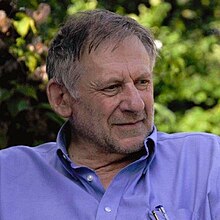
Back كريستوفر الكسندر Arabic كريستوفر الكسندر ARZ Christopher Alexander German Κρίστοφερ Αλεξάντερ (αρχιτέκτονας) Greek Christopher Alexander Spanish Christopher Alexander Estonian کریستوفر الکساندر Persian Christopher Alexander Finnish Christopher Alexander French כריסטופר אלכסנדר HE
Christopher Alexander | |
|---|---|
 Alexander in 2012 | |
| Born | Christopher Wolfgang Alexander 4 October 1936 |
| Died | 17 March 2022 (aged 85) Binsted, Sussex, United Kingdom |
| Nationality | American / British |
| Alma mater | Oundle School Trinity College, Cambridge Harvard University (PhD) Massachusetts Institute of Technology |
| Occupation | Architect |
| Awards | Vincent Scully Prize Global Award for Sustainable Architecture |
Christopher Wolfgang John Alexander (4 October 1936 – 17 March 2022)[1][2][3] was an Austrian-born British-American architect and design theorist. He was an emeritus professor at the University of California, Berkeley. His theories about the nature of human-centered design have affected fields beyond architecture, including urban design, software, and sociology.[4] Alexander designed and personally built over 100 buildings, both as an architect and a general contractor.[5][6]
In software, Alexander is regarded as the father of the pattern language movement. The first wiki—the technology behind Wikipedia—led directly from Alexander's work, according to its creator, Ward Cunningham.[7][8][9] Alexander's work has also influenced the development of agile software development.[9]
In architecture, Alexander's work is used by a number of different contemporary architectural communities of practice, including the New Urbanist movement, to help people to reclaim control over their own built environment.[10] However, Alexander was controversial among some mainstream architects and critics, in part because his work was often harshly critical of much of contemporary architectural theory and practice.[11]
Alexander is best known for his 1977 book A Pattern Language, a perennial seller some four decades after publication.[12] Reasoning that users are more sensitive to their needs than any architect could be,[13][14][15] he collaborated with his students Sara Ishikawa, Murray Silverstein, Max Jacobson, Ingrid King, and Shlomo Angel to produce a pattern language that would empower anyone to design and build at any scale.
His other books include Notes on the Synthesis of Form, A City is Not a Tree (first published as a paper and re-published in book form in 2015), The Timeless Way of Building, A New Theory of Urban Design, and The Oregon Experiment. More recently he published the four-volume The Nature of Order: An Essay on the Art of Building and the Nature of the Universe, about his newer theories of "morphogenetic" processes, and The Battle for the Life and Beauty of the Earth, about the implementation of his theories in a large building project in Japan.
- ^ "PatternLanguage.com". www.patternlanguage.com.
- ^ "CA FRAME". www.patternlanguage.com. Archived from the original on 19 March 2022. Retrieved 10 February 2016.
- ^ "Media". Sustasis. Retrieved 20 March 2022.
- ^ "Book of Members, 1780–2010: Chapter A" (PDF). American Academy of Arts and Sciences. Archived (PDF) from the original on 18 June 2006. Retrieved 14 April 2011.
- ^ "Christopher Alexander". www.pps.org.
- ^ "2009 Scully Prize". nbm.org. Archived from the original on 16 February 2016. Retrieved 12 February 2016.
- ^ "C2 Wiki Front Page".
- ^ "C2 Wiki: People, Projects and Patterns".
- ^ a b Cunningham, Ward; Mehaffy, Michael W. (2013). "Wiki as pattern language". Proceedings of the 20th Conference on Pattern Languages of Programs, October 23–26, 2013, Monticello, Illinois. PLoP '13. Corryton, TN: The Hillside Group. pp. 32:1–32:14. ISBN 978-1-941652-00-8.
- ^ Rybczynski, Witold (2 December 2009). "Do You See a Pattern?". Slate.
- ^ Nikos Salingaros, "A Theory of Architecture", Umbau-Verlag, Solingen, 2009
- ^ Alexander, Christopher (20 September 2018). A Pattern Language: Towns, Buildings, Construction. Oxford University Press. ISBN 978-0-19-005035-1.
- ^ Alexander, Christopher; Alexander, Professor in the Department of Architecture Christopher; Silverstein, Murray; Angel, Shlomo; Ishikawa, Sara; Abrams, Danny (7 June 1975). The Oregon Experiment. Oxford University Press. p. 42. ISBN 978-0-19-501824-0 – via Internet Archive.
Christopher Alexander users of a building know more.
- ^ Gehl, Jan; Svarre, Birgitte (1 October 2013). How to Study Public Life. Island Press. ISBN 978-1-61091-525-0 – via Google Books.
- ^ "The Oregon Experiment after Twenty Years - RAIN". www.rainmagazine.com.
© MMXXIII Rich X Search. We shall prevail. All rights reserved. Rich X Search